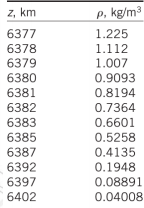The density of atmospheric air varies with elevation, decreasing with increasing altitude. (a) Using the data given in the table, obtain a relation for the variation of density with elevation, and calculate the density at an elevation of 7200m. (b) Calculate the mass of the atmosphere using the correlation you obtained. Assume the earth to be a perfect sphere with a radius of 6377 km, and take the thickness of the atmosphere to be 25 km.
The density of atmospheric air varies with elevation, decreasing with increasing altitude. (a) Using the data given in the table, obtain a relation for the variation of density with elevation, and calculate the density at an elevation of 7200m. (b) Calculate the mass of the atmosphere using the correlation you obtained. Assume the earth to be a perfect sphere with a radius of 6377 km, and take the thickness of the atmosphere to be 25 km.
Related questions
Question
please help me with this....

Transcribed Image Text:z, km
P, kg/m3
6377
1.225
1.112
1.007
0.9093
0.8194
0.7364
6378
6379
6380
6381
6382
6383
6385
6387
6392
6397
6402
0.6601
0.5258
0.4135
0.1948
0.08891
0.04008

Transcribed Image Text:The density of atmospheric air varies with elevation, decreasing with increasing altitude.
(a) Using the data given in the table, obtain a relation for the variation of density with elevation,
and calculate the density at an elevation of 7200 m.
(b) Calculate the mass of the atmosphere using the correlation you obtained. Assume the earth
to be a perfect sphere with a radius of 6377 km, and take the thickness of the atmosphere to
be 25 km.
Expert Solution
This question has been solved!
Explore an expertly crafted, step-by-step solution for a thorough understanding of key concepts.
This is a popular solution!
Trending now
This is a popular solution!
Step by step
Solved in 2 steps with 2 images
